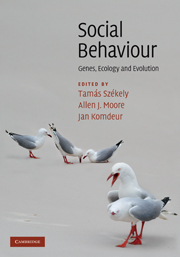Book contents
- Frontmatter
- Contents
- List of contributors
- Introduction: The uphill climb of sociobiology: towards a new synthesis
- Profile: Undiminished passion
- Part I Foundations
- Part II Themes
- 7 Aggression: towards an integration of gene, brain and behaviour
- Profile: From behavioural observations, to genes, to evolution
- 8 Social influences on communication signals: from honesty to exploitation
- Profile: Reputation can make the world go round – or why we are sometimes social
- 9 Important topics in group living
- Profile: A haphazard career
- 10 Sexual behaviour: conflict, cooperation and coevolution
- Profile: In celebration of questions, past, present and future
- 11 Pair bonds and parental behaviour
- Profile: Mating systems and genetic variation
- 12 Adaptations and constraints in the evolution of delayed dispersal: implications for cooperation
- Profile: Selections from a life in social selection
- 13 Social behaviour in microorganisms
- Profile: The de novo evolution of cooperation: an unlikely event
- 14 Social environments, social tactics and their fitness consequences in complex mammalian societies
- Profile: Evolutionary genetics and social behaviour: changed perspectives on sexual coevolution
- 15 Social behaviour in humans
- Profile: Genes and social behaviour: from gene to genome to 1000 genomes
- Part III Implications
- Species index
- Subject index
- References
Profile: Genes and social behaviour: from gene to genome to 1000 genomes
Published online by Cambridge University Press: 05 June 2012
- Frontmatter
- Contents
- List of contributors
- Introduction: The uphill climb of sociobiology: towards a new synthesis
- Profile: Undiminished passion
- Part I Foundations
- Part II Themes
- 7 Aggression: towards an integration of gene, brain and behaviour
- Profile: From behavioural observations, to genes, to evolution
- 8 Social influences on communication signals: from honesty to exploitation
- Profile: Reputation can make the world go round – or why we are sometimes social
- 9 Important topics in group living
- Profile: A haphazard career
- 10 Sexual behaviour: conflict, cooperation and coevolution
- Profile: In celebration of questions, past, present and future
- 11 Pair bonds and parental behaviour
- Profile: Mating systems and genetic variation
- 12 Adaptations and constraints in the evolution of delayed dispersal: implications for cooperation
- Profile: Selections from a life in social selection
- 13 Social behaviour in microorganisms
- Profile: The de novo evolution of cooperation: an unlikely event
- 14 Social environments, social tactics and their fitness consequences in complex mammalian societies
- Profile: Evolutionary genetics and social behaviour: changed perspectives on sexual coevolution
- 15 Social behaviour in humans
- Profile: Genes and social behaviour: from gene to genome to 1000 genomes
- Part III Implications
- Species index
- Subject index
- References
Summary
Which comes first – passion for the scientific question or passion for the organism? For most biologists I think it's the former, but for me it was the latter. I became smitten with honey bees at the age of 18 and have never looked back.
Once immersed in study, the question did come: how can a honey bee, with a brain the size of a grass seed, create a collective organisation in which all tasks are divided efficiently but flexibly among as many as 50 000 individuals? Honey bee division of labour is a spectacular example of social behaviour; trying to understand its mechanisms and evolution has motivated most of the research in my laboratory over the years and also has led periodically to rewarding expeditions into new scientific terrains.
After starting with behavioural and endocrine analyses as a graduate student at Cornell University with Roger Morse, my postdoctoral studies with Robert Page at Ohio State University demonstrated for the first time heritable influences on division of labour (Robinson & Page 1988). Then mechanistic studies in my own lab at the University of Illinois revealed striking differences in brain chemistry and brain structure between bees performing different jobs, raising the possibility that these changes were orchestrated by changes in brain gene expression (Withers et al. 1993). To enhance our ability to discover insights into the mechanisms and evolution of this form of social behaviour, I decided in the mid 1990s to initiate a molecular component to our research programme.
- Type
- Chapter
- Information
- Social BehaviourGenes, Ecology and Evolution, pp. 410 - 414Publisher: Cambridge University PressPrint publication year: 2010



